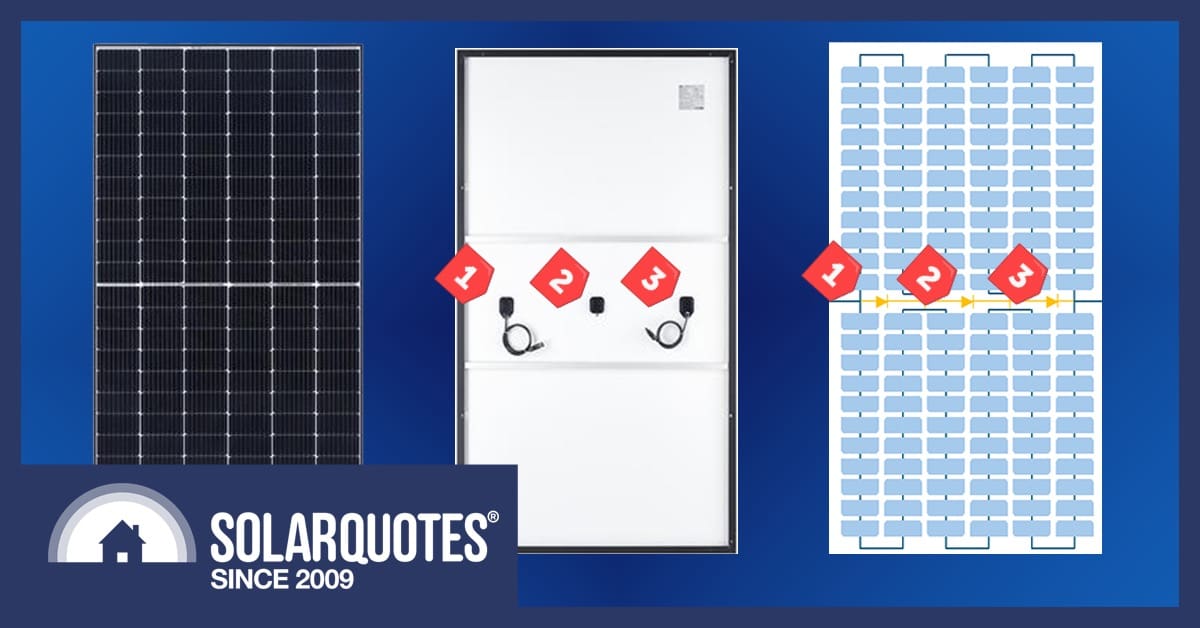
Solar panel bypass diodes – those unassuming little electronic components quietly working in the background of your solar panels. What are they, why are they there, and do we really need them?
Bypass Diodes 101
Diodes are electrical components that allow current to flow in one direction while blocking it in the opposite direction. You could think of them as one-way valves for electricity. They’re ubiquitous in the modern world, and many electrical and electronic devices wouldn’t work properly without them. This post will explain how bypass diodes in modern, split-cell, solar panels work.
If you’re familiar with electronics, you’ve probably used diodes that look like this:
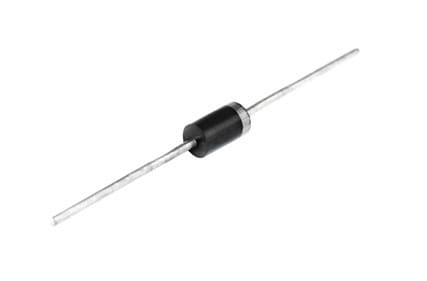
But the bypass diodes in modern solar panels are more likely to use this form factor: 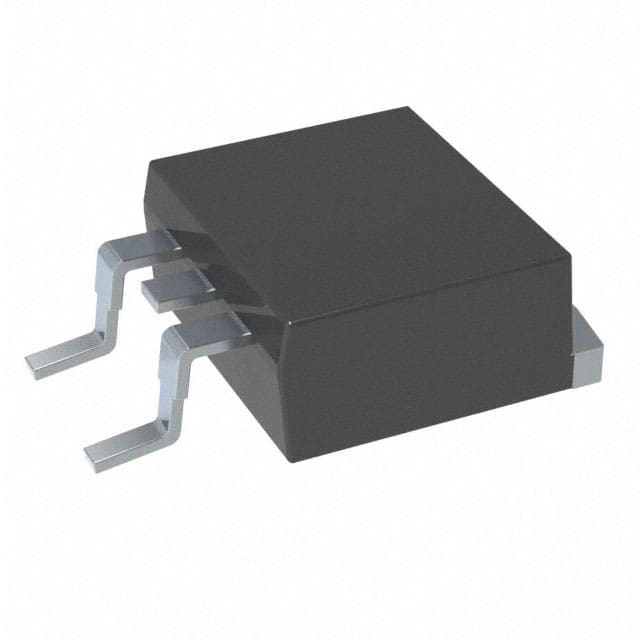 Bypass diodes are located on the back of your solar panels. Most modern solar panels have 3 diodes, one diode in each of three plastic junction boxes:
Bypass diodes are located on the back of your solar panels. Most modern solar panels have 3 diodes, one diode in each of three plastic junction boxes:
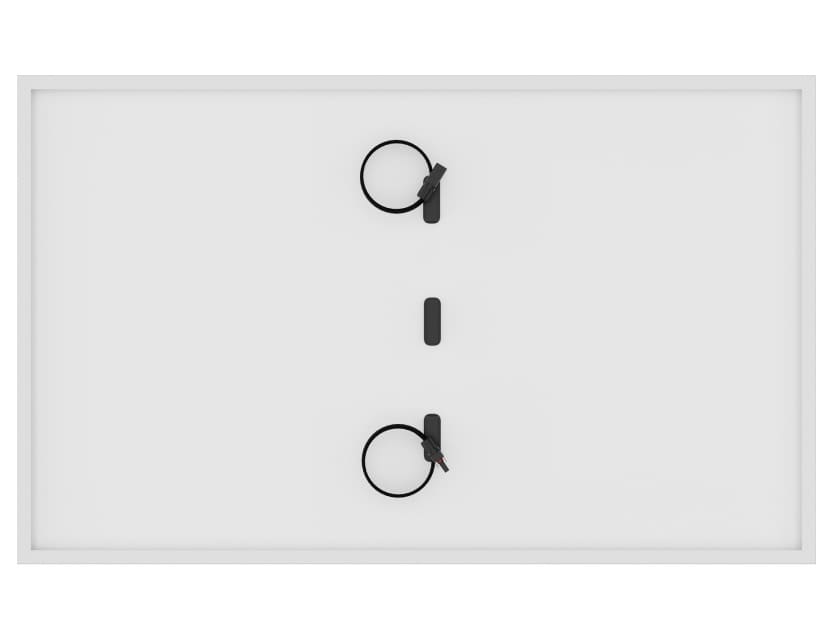
A modern solar panel has 3 junction boxes on the back for 3 bypass diodes.
Here you can see the diodes inside the junction boxes:
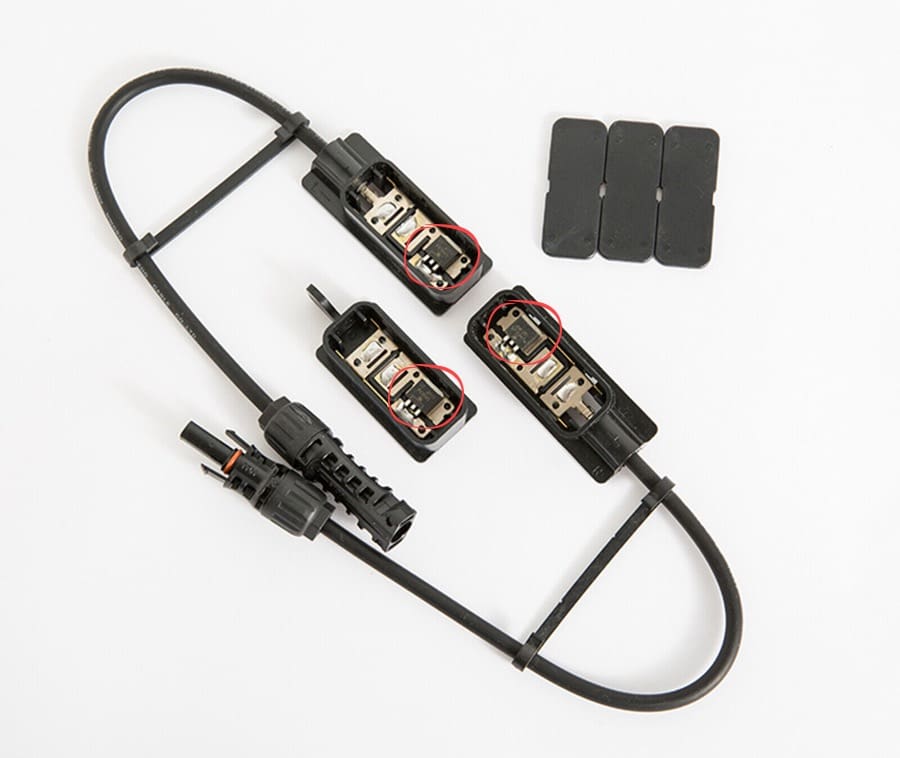
Bypass diodes circled.
As the name suggests, bypass diodes are used to bypass shaded solar cells. They stop shaded, high-resistance cells from getting ‘hot spots’ and reduce the power loss in the partially shaded panel.
How Bypass Diodes Work In Modern Solar Panels
A modern solar panel is typically 132 half-cells connected in series. Bypass diodes are connected across the sub-strings of cells like this:
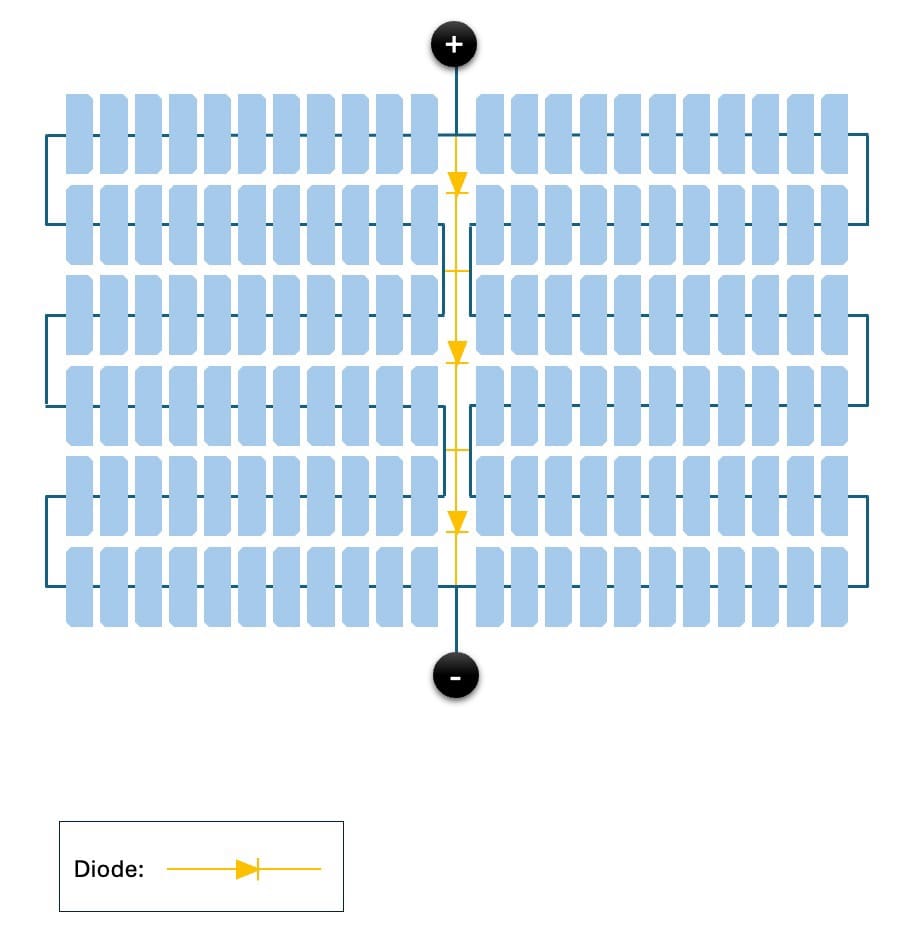
How bypass diodes are connected in a modern, split-cell solar panel.
Bypass diodes and shaded solar cells
When a solar cell or cells are shaded, they can block the current flowing through the solar panel. If the current can’t go through the shaded cells, there are 2 possible diversions.
Option #1: Through the bypass diode, bypassing the blocked sub-string and the one opposite, and flowing through 4 sub-strings:
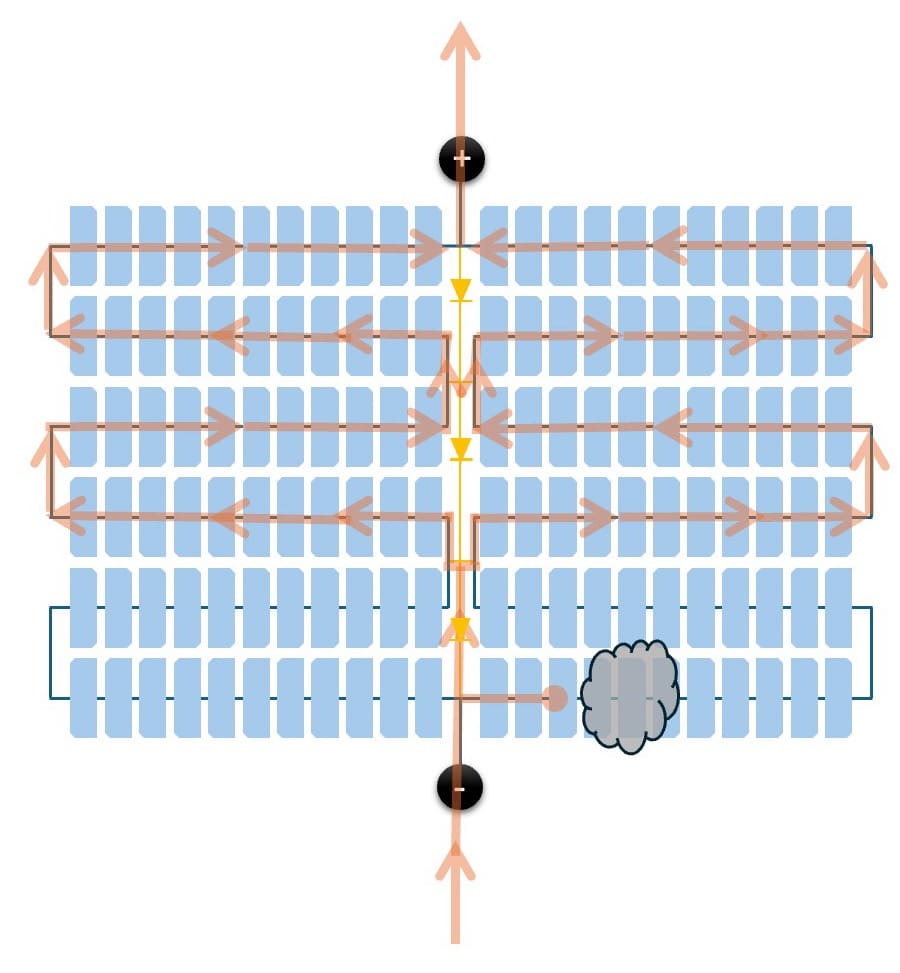
How by-pass diodes are connected in a modern, split-cell solar panel.
Option #2: Through the opposite sub-string, flowing through 5 sub-strings:
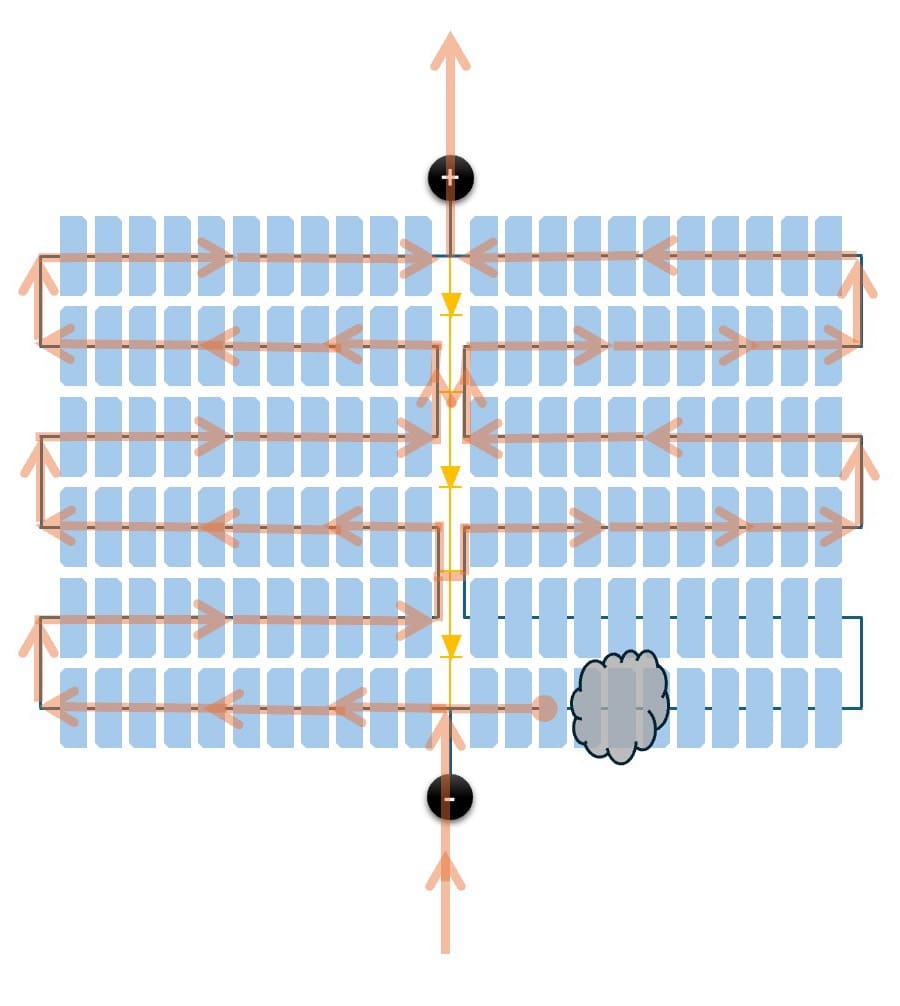
Option #2: the current can’t get through the shaded cells, or the diode so it diverts through the opposite cell-string.
So which way does the current go? The software in your inverter decides.
Your inverter decides whether to activate the bypass diode
Your inverter can choose to increase the current enough that the bypass diode is activated (option #1 above) or the inverter can reduce the current so that the diode is not activated (option #2).
Counterintuitively, a good inverter (that is, an inverter with good MPPT software) would choose option #1, pushing the current through only 66% of the solar cells.
But wouldn’t using 66% of the cells generate less power than option #2 which uses 83% of the cells?
No, because using a current high enough to activate the bypass diode allows a combination of high current and lower voltage that, multiplied together (Power = Current x Voltage), gives more power than the lower current and higher voltage of option #2.
This is cleared up by looking at the shaded panels’ Power & I-V curves:
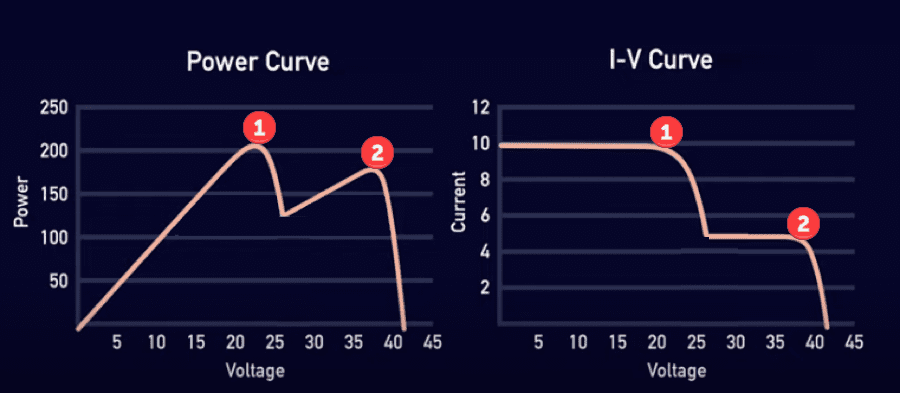
Image Credit: GSES
The red circles represent the two options #1 & #2. As you can see option #1 gives more power. The higher current more than makes up for the lower voltage. So a good inverter will take option #1.
Is activating the bypass diode always the best option?
No – it depends on the shade pattern.
For example, if 2 sub-strings are fully shaded, the most power will usually be had by dropping the current and not activating the bypass diodes:
How does the inverter know which option is best?
The inverter regularly ‘scans’ the power curve by quickly trying lots of voltages and looking for the voltage that gives the highest power, and then going there until it re-scans.
How does it work with multiple solar panels?
The example above is for one panel. The maximum power point for a whole array of solar panels will look different and depend on many variables including the shade pattern across the array. A good string inverter will scan the power curve for the whole array, and choose the voltage and current that delivers maximum power. A microinverter or DC optimiser system will do this for each individual panel instead of the whole string.
Bypass Diodes save one shaded panel bringing down the whole string.
When the whole panel is shaded, all three diodes activate, the whole solar panel is completely bypassed and that panel produces no power.
If a shaded solar panel is wired in a series string with a bunch of other solar panels, it allows current to flow through those unshaded panels that would otherwise have their output severely compromised or even completely shut down. It’s a simple and clever idea to reduce the losses in a shaded string, but far from a perfect solution, as you’ll see if you read on.
Bypass Diode Failure
Like all electronic components, diodes can be prone to failure if pushed too hard. When a bypass diode is activated, some of the energy passing through it is also dissipated as heat. If the same shading event happens day in and day out, there may come a point where the workload is too much to bear, and the diode breaks down.
Shading isn’t always the culprit though. Failure can be caused by voltage surges from lightning or electrical faults and even moisture ingress. You could also be unlucky enough to cop a bad batch from the manufacturer.
Solar installers have reported bypass diodes failing as both open and closed circuits. If closed, the cells in the affected sub-string are bypassed, permanently reducing the solar panel’s output. If failed as an open circuit, there’s limited shading protection, and the panel is vulnerable to hot spots.
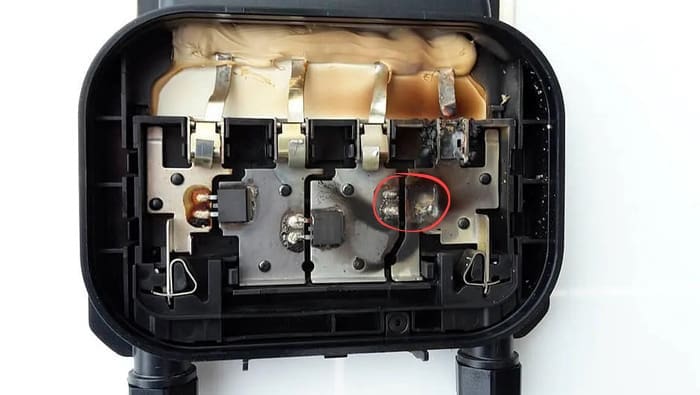
Older style (not split-cell) solar panel junction box with bypass diodes. The right one has been completely blown away. Image: Winaico
Determining Defective Bypass Diodes
How do you know if your bypass diodes have failed? Short of physically removing the panels from the roof, opening the junction box, and testing them, there are a few telltale signs but no definitive answer unless you do just that; test them with a multimeter.
- Visual inspection: If you can get close enough, you could eyeball your panels and check for hot spots. However, even if hot spots were prominent, your bypass diodes may not be the culprit. If, however, there was hard shading from objects on or near the roof that lined up closely with the said hot spots, your detective work may be worth something.
- Performance monitoring: A significant loss in energy production coupled with shading events may indicate a defective bypass diode, although it’s a giant leap of faith. The more sophisticated your monitoring, the more chance you can pinpoint the problem. That’s where panel-level monitoring with microinverters and optimisers has the edge over string inverters. Bear in mind the culprit may also be the optimiser or micro-inverter!
- Thermal imaging: Why not hire a thermal imaging camera1 and check for hot spots on your solar panels? It could be fun if nothing else, and you could get bang for your buck by checking the thermal envelope of your house interior for air gaps or weaknesses at the same time. To be honest, that’s more likely going to be the place where you lose most energy, and not your solar panels.
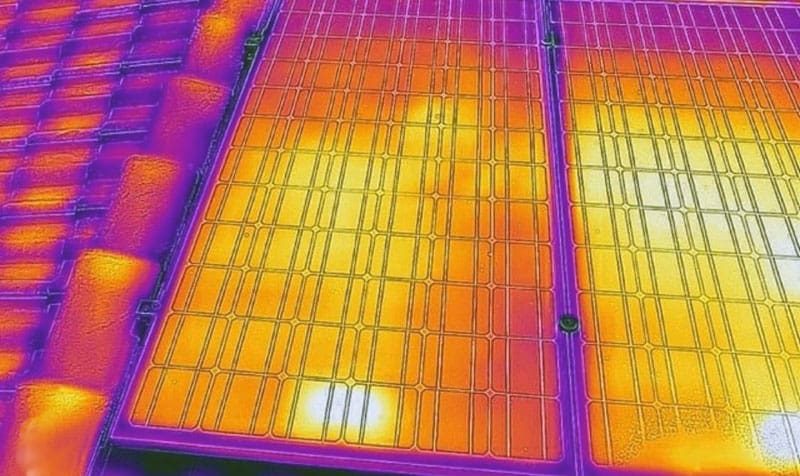
Solar panel thermal imaging. This will pick up hot spots but you’ll need further diagnostics to find out how they happened. Image: GI Energy
Replacing Faulty Bypass Diodes
Can you replace faulty bypass diodes? Yes, but don’t bother unless your system is out of warranty or you’re a DIYer who likes to muck around in the shed and you’re prepared to trash a panel or two. You may find a can of worms once you crack open the junction box.
Some junction boxes have potting gel encasing the diodes, so it’s a job and a half to get to them. It’s not uncommon to break the tabs holding the lid too, so good luck trying to seal it up again. You may be up for a whole new junction box.
In most cases, solar installers are unlikely to remove or attempt to replace bypass diodes under warranty unless the manufacturer requests it. They will certainly test the panel’s performance, but if things aren’t up to spec, replacing the whole panel is usually quicker and cheaper.
The only caveat to the above is if you suspect a diode is faulty, and they don’t make the panels anymore, then maybe, as a last resort, roll the dice and give it a try. There are videos online attempting to help out, but even the most popular DIY YouTubers sometimes get it wrong!
If You’re A Solar Panel, Stay Out Of The Shade
As you can see, solar panel bypass diodes are a double-edged sword. While they offer protection against shading-induced damage and power loss, they’re not immune to failure themselves. This article barely scratches the surface of this fascinating subject (for energy nerds.) Whether you’re a fan of microinverters or optimisers or just happy to let bypass diodes take the load, one thing’s for sure – if you’re a solar panel, it’s best to stay out of the shade.
Footnotes
- Some libraries loan them for free ↩

 RSS - Posts
RSS - Posts



Nice article, so many elements to healthy PV system , its telling that a unserviceable 50cent diode can greatly reduce system efficiency or even cause a fire in extreme circumstances.
Just a query re current flow. Your diagrams have bypass and blocker diodes with arrow facing negative.
I may be wrong and have mainly had experience with ELV RV solar where have used inline blocker diodes to isolate parallel panels of different orientation . But I’ve always built the array with diode arrow towards positive.
Hi Kim,
I had an issue with solar panel diodes not activating when they became shaded from the top half of the panel. I had to turn off the dc isolator switch to that string and turn it back on after a few seconds and that activated the diodes in the panels . If I didn’t turn it off the 2 strings would stop performing and reduced output by 90%. This could of potentially burn out panels or worst case scenario,start a fire.
To remedy the problem I put optimizers on the 3 offending panels and that fixed the problem.
But I was not monitoring the system I would never have known this was happening and I wonder if this a contributing factor in fires which occur on solar panels.
What inverter were you using?
Hi Kim
I believe you have the bypass diodes in the diagram in the wrong polarity.
Yup, as shown, the diodes short out the panel. They need to be be flipped so that they are reverse biased (non-conducting) in normal operation. Only when the rest of the (generating) string makes the occluded substring a voltage drop due to its resistive losses at the higher string current, not a generator, should the reversed diode conduct.
A waterflow analogy might help: 4 pumps in series, each with a bypass valve. One pump blocks. The bypass valve must allow flow from the other three, not short circuit its pump in normal operation.
(The symbol illustrates conventional current, not electron flow, so it’s the bar on the nose which is the cathode. Don’t blame me, I didn’t choose to add that confusion.)
My mistake. I drew the diagrams for this post.
Diagrams fixed. Thanks for pointing that out.
Hi Finn,
I’m confused with the direction of current flow in the diagram. I think the current should going negative to positive (internally) as its a power source (voltage generator). Bypass diodes orientation looks ok now.
Yes – my mistake, again! Diagrams fixed – I think we’re finally there now.
Looks like you’ve reversed the solar arrays’ polarity ok but now the direction of the diodes are reversed? I think you might have to do both to make it right. But hey thanks for article – there is a lot of interesting stuff in there! appreciated
Hi ,in the above diagrams you have your diodes in reverse direction
Now that we know bypass diodes prevent 1 shaded panel dragging down the entire array, can you please update the advice on this page – https://www.solarquotes.com.au/lp/top-7-mistakes-c/
Good point Mark, thank you – updated.